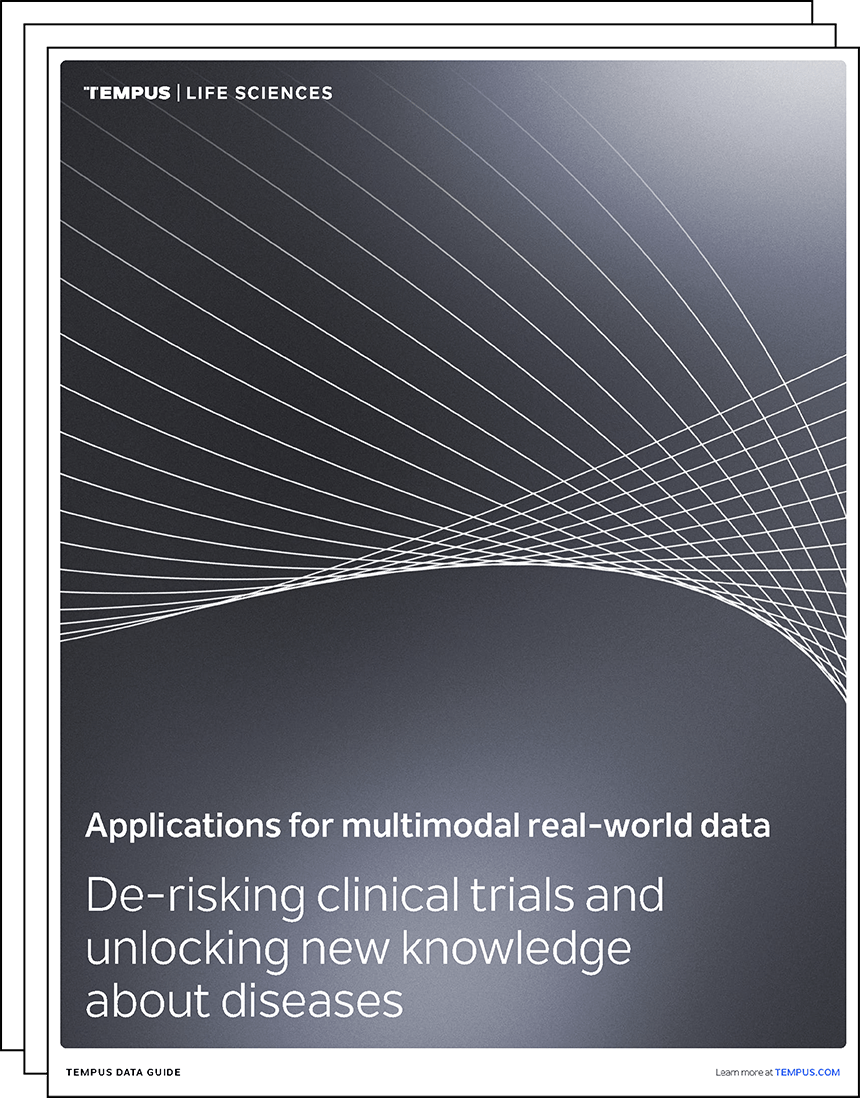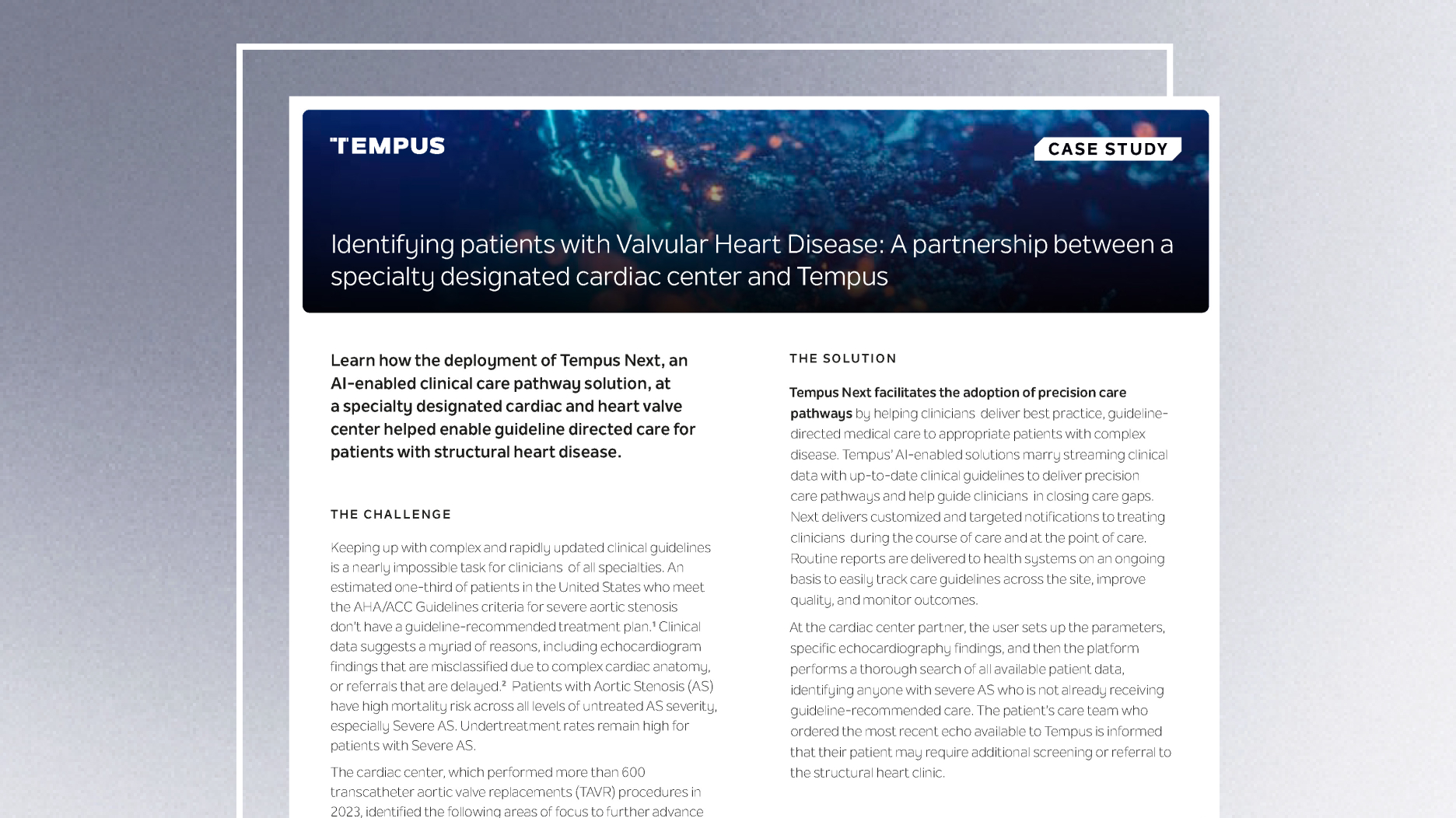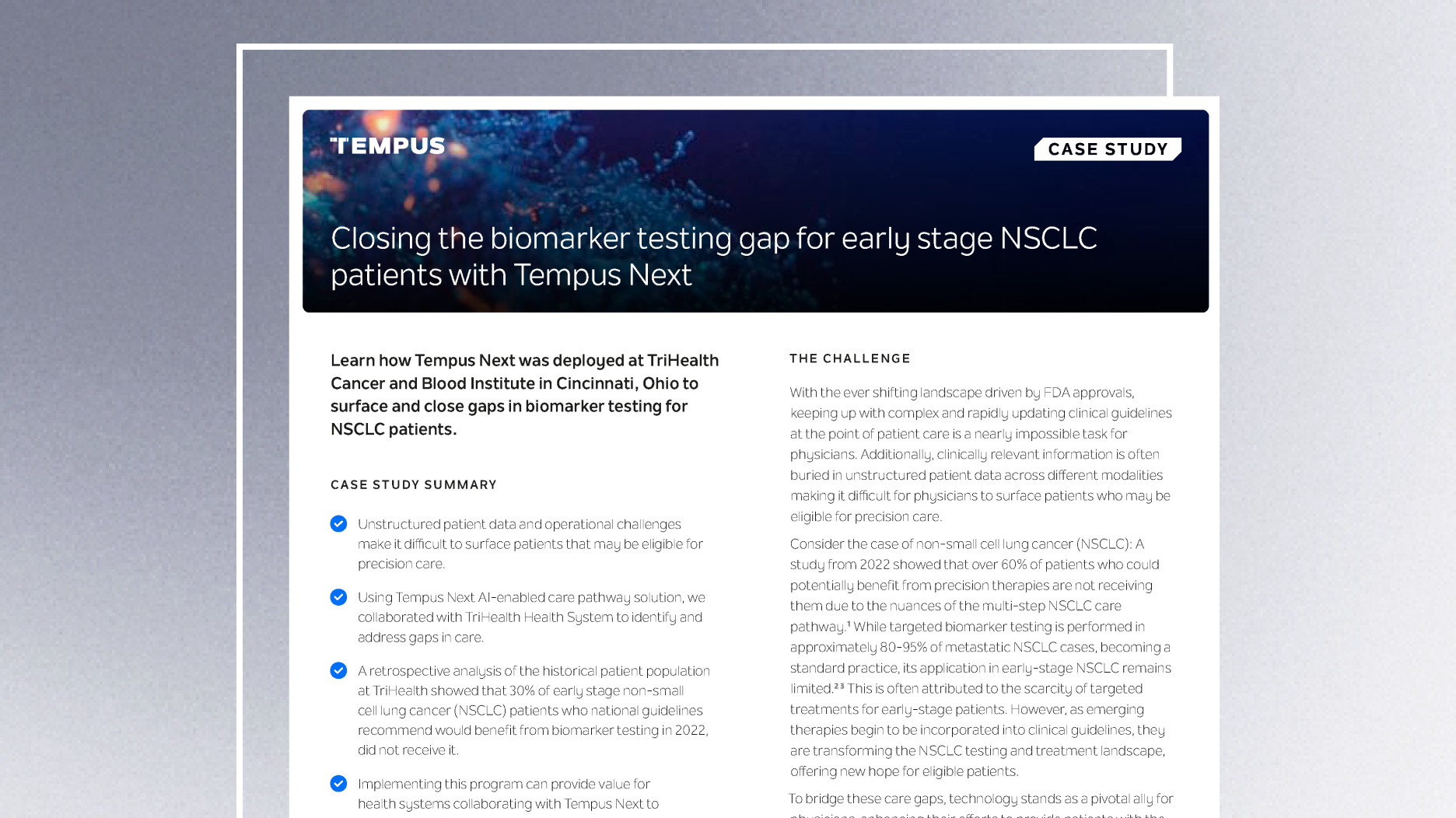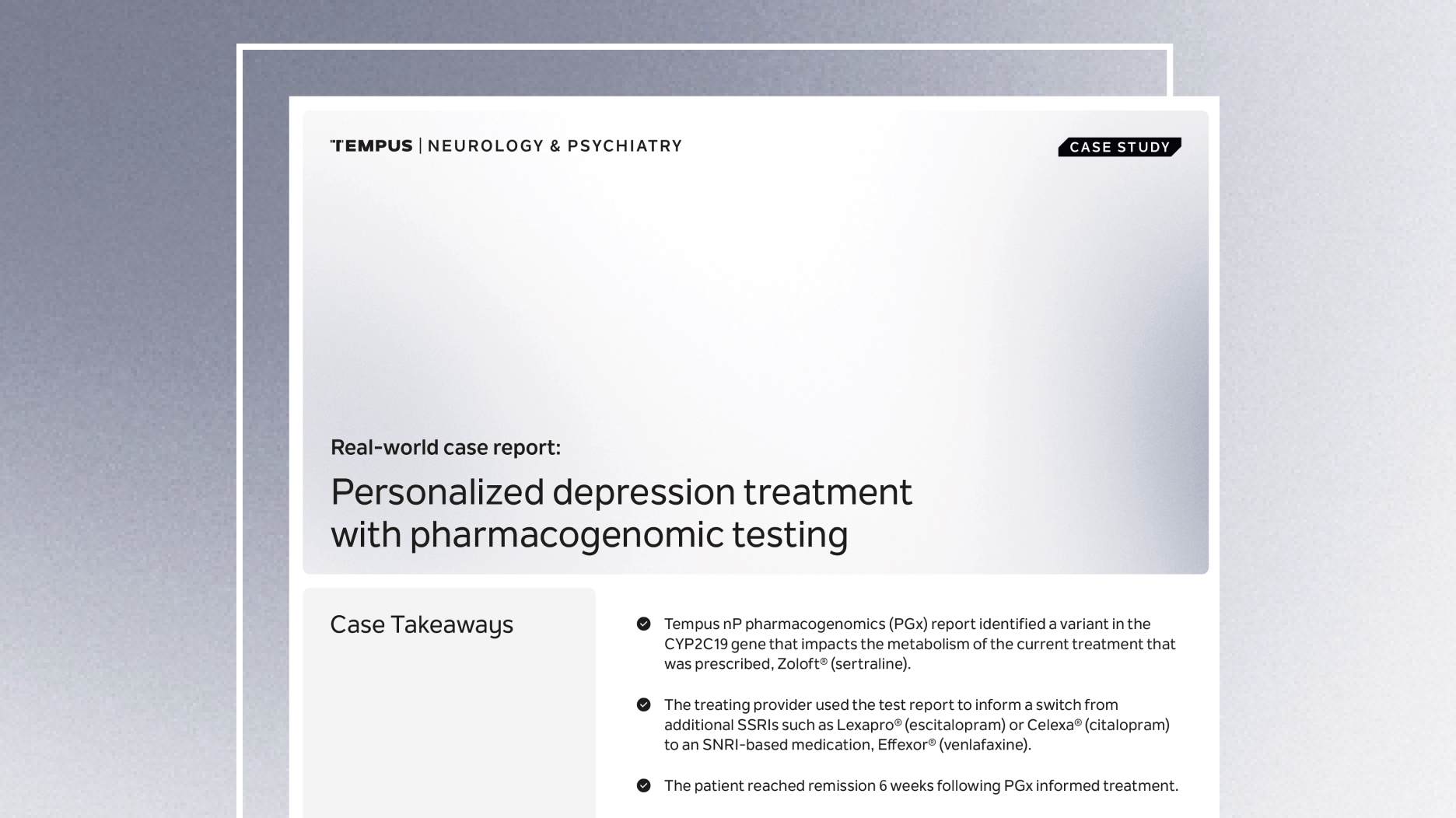-
PROVIDERS
Read more
Browse our latest selection of abstracts, manuscripts, and presentations.
- LIFE SCIENCES
-
PATIENTS
It's About Time
View the Tempus vision.
- RESOURCES
-
ABOUT US
View Job Postings
We’re looking for people who can change the world.
08/11/2022
Unlocking the value of RNA data
Authors
Ryan Fukushima, Chief Operating Officer, and Nike Beaubier, MD, Senior Vice President, Life Science Pathology
Achieving the promise of precision medicine in oncology requires us to go beyond traditional research paradigms. Precision medicine in oncology accelerated once we had molecular biomarkers to categorize tumors more precisely by their biology, rather than just by tissue of origin. For example, we can now categorize patients using a biomarker-based approach that groups populations with similar tumor biology, like homologous recombination repair deficiency, instead of treating all breast, prostate, or pancreatic cancers similarly. Initial discoveries with DNA-based biomarkers have made significant strides in oncology treatment and research, but in order to truly understand a cancer’s genetic makeup, researchers need to go further. With the proper level of detail in the data we use, we can be more precise in our efforts to target and treat cancer.
RNA, a rich source of biological data, provides the breadth and granularity needed to revolutionize clinical research and drug development. Specifically, whole transcriptome RNA profiling enables researchers to unlock more potentially clinically actionable data about a tumor. With a full picture of a cancer’s genetic makeup, we can help physicians guide patient care today while also generating the necessary data to power therapeutic discovery for the future.
What is whole transcriptome RNA sequencing?
Whole transcriptome RNA sequencing measures gene expression comprehensively across adult human coding genes, which is the portion of a gene’s RNA that codes for protein. This means we can detect translocations/fusion genes when testing tumor samples. Translocations are chromosomal rearrangements in which the regulatory region of one gene is “fused” to the effector domain of another gene, thus creating a chimeric protein with dysregulated activity. Translocations are some of the most targetable and therefore clinically important biomarkers in oncology. Because the whole transcriptome is represented in Tempus’ sequencing assay, translocations can be detected in an unbiased fashion, including when a driver gene is fused to a non-canonical partner. Thus, more translocations are detected for potential therapy selection or clinical trial enrollment.
Whole transcriptome RNA sequencing, and therefore analysis of translocations/fusion genes, can provide more results than just DNA-only sequencing. A Tempus study found that, among patients with identified clinically actionable fusions using the Tempus xT assay, RNA sequencing identified 29% more patients with such fusions that were matched to biomarker linked therapies and that would have been missed by DNA sequencing alone.
For example, NY-ESO-1 is a protein with extremely limited distribution in adults (the only normal expression is in testicular germ cells, an immunoprivileged site), however it is often aberrantly expressed in tumor cells. NY-ESO-1 is regularly used as a target for immunotherapy or T-cell therapy, but it can not be detected with DNA sequencing since it is not mutated. Whole transcriptome RNA sequencing can detect its expression in tumors.
Whole transcriptome RNA sequencing also unlocks a range of insights at once, surpassing the reach of traditional methods in which researchers assessed one gene at a time or small panels to look for abnormalities. Novel fusion detection, alternative splicing events, disease subtyping, and prognostic/predictive signatures are some of the data points and tests made possible with a whole transcriptome approach.
While generating and validating RNA sequencing for clinical results can be more challenging than DNA sequencing due to the fragility of RNA in preserved tissue, the dynamic range of expression, and few preexisting orthogonal validation assays, these characteristics also provide opportunity in the form of novel insights from a rich data source.
Value of RNA for R&D
Whole transcriptome RNA sequencing directly impacts patient treatment today, but there is immense value in advancing critical R&D work to stratify populations into more precise groups that may respond better to novel therapeutics. In clinical trials, for example, matched DNA, RNA, and clinical datasets enable researchers to design clinical trials more precisely to find the optimal patient populations that can benefit from the drug being tested in the trial.
While some RNA data has been publicly available for years – for example, through the The Cancer Genome Atlas Program (TCGA), a database founded in 2006 – it hasn’t been linked with outcomes data, therefore hampering understanding of whether or not certain therapies are effective in treating a patient’s cancer. As an early adopter of whole transcriptome RNA sequencing, Tempus has built one of the largest data repositories of RNA and the only dataset offering matched RNA, DNA, and outcomes data that is connected to the clinical care of today.
At Tempus, we collaborate with many hospitals such as Intermountain Healthcare, a Utah-based nonprofit healthcare system, to generate whole transcriptomic data on existing genetic samples to power clinical research. Our team performs whole transcriptome RNA sequencing, complete with validated fusion detection, to provide deeper molecular profiling. These RNA insights supplement DNA data to provide a full picture of a genetic sample. Intermountain will use the matched RNA and DNA data to further its oncology research, advance patient care, and improve outcomes.
Value of RNA for biopharma
Similarly, Tempus collaborates with many of the country’s top pharmaceutical companies to support their R&D efforts to develop drugs to address unmet needs of cancer patients.
For biopharma organizations, the key use case for RNA is in better pinpointing patient populations that may respond to indications or investigational therapies. Some biopharma organizations also use RNA to optimize a drug’s resistance profile, using the rich RNA data to understand whether or how tumors develop immunity to a treatment over time, then adjusting the therapy to make it more effective.
Whole transcriptome RNA sequencing – including analyses of how genes may fuse together – can identify biomarkers that connect a drug to the part of a tumor where it would have the greatest effect. Since Tempus’s dataset of matched RNA, DNA, and clinical data is longitudinally updated, we’re able to work with researchers to run signatures in order to see which treatments were given to which patients and assess how it impacted their outcome. We support over 120 global biopharma customers in these types of analyses, as well as other analytical approaches that combine RNA and DNA data to best position the next class of oncology therapeutics.
Looking ahead: Future opportunities for RNA to fuel innovation
Today’s developments in RNA data analysis technology only scratch the surface of possible applications for RNA in oncology. With so much more left to discover, Tempus is at the forefront of leveraging RNA sequencing data at scale, testing novel approaches in clinical trials – including RNA expression and overexpression – to hopefully improve the probability of success of the next class of precision medicines.
Learn more

Learn more
Applications for multimodal real-world data
De-risking clinical trials and unlocking new knowledge about diseases
DOWNLOAD GUIDEStay informed
Be notified whenever Tempus publishes new and relevant research, webinars, and other resources.
Sign up-
04/15/2024
Identifying patients with Valvular Heart Disease: A partnership between a specialty designated cardiac center and Tempus
Learn how the deployment of Tempus Next, an AI-enabled clinical care pathway solution, at a specialty designated cardiac and heart valve center helped enable guideline directed care for patients with structural heart disease.
Read more -
04/15/2024
Closing the biomarker testing gap for early stage NSCLC patients with Tempus Next
Learn how Tempus Next was deployed at TriHealth Cancer and Blood Institute in Cincinnati, Ohio to surface and close gaps in biomarker testing for NSCLC patients.
Read more -
11/15/2023
Personalized depression treatment with pharmacogenomic testing
This real-world case shows the impact of using the Tempus nP PGx report to inform treatment in major depressive disorder (MDD).
Read more


